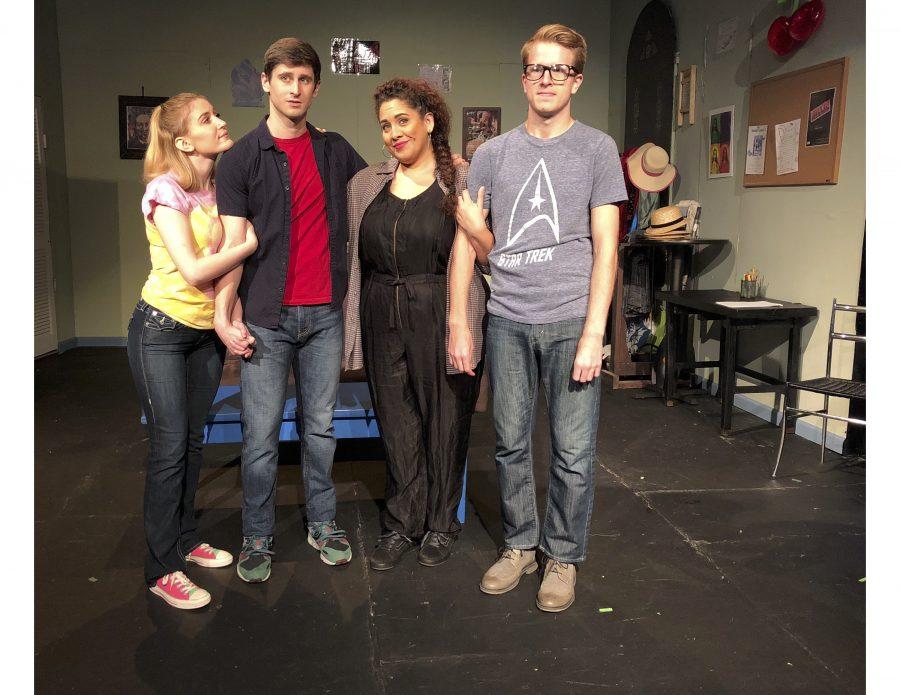“The Green Room,” which made its New York premiere Off-Broadway on Sept. 27, tackles the gravity of our choices — in our relationships, careers and education — and how they either strengthen or threaten our pursuit of success.
It is a strong message on which to build a coming-of-age story, but whether this new arrival used the opportunity well is another question.
The show centers around four theatre students: Anna (Sami Staitman), her friend Divonne (Ariana Valdes), her boyfriend John (Corbin Williams) and her brother Cliff (played by Tisch New Studio alumnus Eli Douglas LaCroix). The show takes place in a green room, where the characters navigate personal relationships, cram 2,000 years of theatre history and memorize monologues, all while trying to create a new musical that could get them on an Off-Broadway stage.
The play features a pleasant variety of musical numbers, from the electrifying “Bachelor’s Anthem,” to the comical “Nothing Can Stop My Boys,” to the soulful, melancholic “The All-You-Wanna-Do-Me Blues”.
Also in the playlist is “It’s All About Me,” an award-winning song that Divonne sings about her minorly successful acting career to cheer herself up. Valdes does not disappoint with her powerful vocals, and the cast as a whole gives an impressive vocal performance. All the harmonies hit home — especially the ambitious four-part acapella harmony in “We’ve Got Style,” whose belting notes were nothing short of glorious.
Plot-wise, however, the show is less sensational. It takes a long while for the stakes to be raised, or for the audience to realize the motivations of the characters. It feels as if writers C. Stephen Foster and Rod Damer had worked the script simply to cater to Charles Pelletier’s songs, rather than have the songs support the message of the libretto.
The first act meanders through the students’ highs and lows, foregrounding their relationship struggles and leaving their actual theatrical endeavors for the last five minutes of the act.
While the actors deliver strong performances, the characters sometimes speak like they are reading from a thesaurus or reciting poetry. This discrepancy creates a distance between the actors and audience; throughout the show, it appears as though the actors are satirizing the struggles of aspiring actors rather than trying to give a sincere portrayal.
The trajectory of each character’s story is often unclear, which makes it difficult for the audience to see how the characters are growing both personally and in their relationships with one another. Only Cliff seems to exhibit any character development by the second act. Coincidentally, he also seems to carry most of the show’s humor.
The jokes are hit-or-miss throughout. The determination to get on Off-Broadway, rather than just on Broadway, is indeed comical in itself. The show’s jokes can be divided into two categories: sexual jokes or theatre jokes — there is no in-between. References to Meisner and Stanislavski might delight some audience members and fly over the heads of others.
These namedrops are successful in reinforcing that these characters are indeed ardent drama majors, but the effect on the audience is that of an inside joke — it excludes some from the conversation.
In essence, “The Green Room” is a whimsical, slightly disjointed love letter to theatre majors. If you’re a thespian and have pulled all-nighters revising greek tragedies, this play might resonate with you.
If you’re not, you’d probably agree with me that “The Green Room,” especially its script, could have used a bit more time on the cutting room floor if it wanted to reach its full potential.
The Green Room is playing at The American Theatre of Actors’ (ATA) Sargent Theatre, 314 W. 54 St., through Oct. 27.
Email Megan Chew at [email protected].
























































































































































